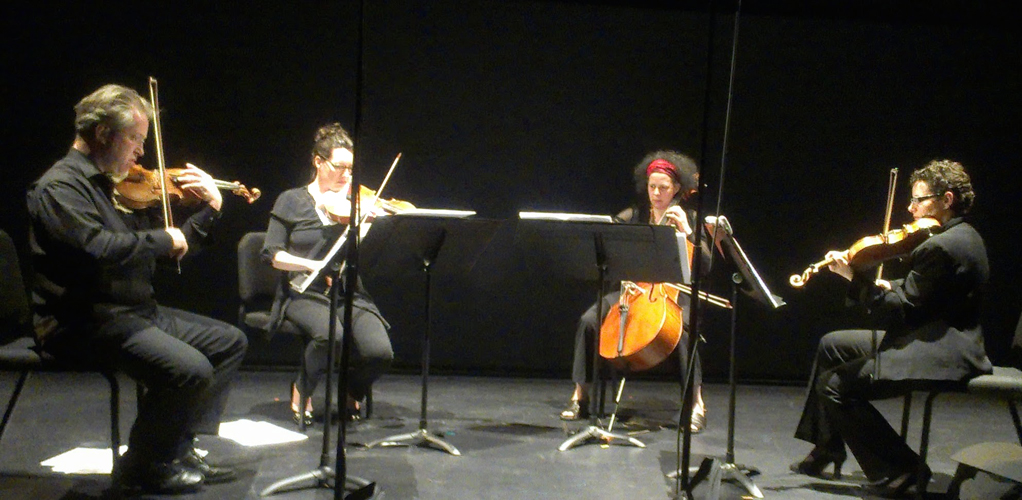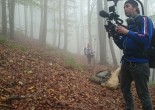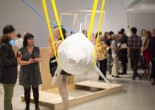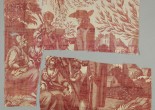Bozzini Lab 2014: Young Composers Shine in Exploration of New Music
Montreal's superb contemporary- and experimental-classical string quartet premiers thrilling new works by emerging Canadian composers.
On a peerless, cloudless, 20º Friday, with the early evening sun still drenching the city and people abandoning their workweek for the beaches and neighbourhood parks in droves, an audience of nearly 60 others filled a dark, black-box-of-a-room deep within SFU’s Goldcorp Centre for the Arts. They had come to the Assembly Room of the Fei & Milton Wong Experimental Theatre, to hear compositions developed by nine young Canadian composers over nine days, working under the tutelage of composer mentors Owen Underhill and Christopher Butterfield and in collaboration with Canada’s premier new music chamber group, the fabulous Bozzini Quartet. It is hard to imagine that even the most optimistic new music enthusiast or the biggest fans of the Bozzini Quartet could have fully anticipated just how thrilling this concert of freshly composed, extremely challenging music would turn-out to be.
The young composers came to the “lab” with the outlines of a piece in-hand. As composer Maren Lisac explained, “Most of us arrived with about five minutes of music written and some ideas about what where we might want to take the piece. Over the nine days, we worked with the quartet to develop and refine ideas, to see what worked and what didn’t work. We discussed these things among ourselves and mostly we wound-up adding to the ideas we brought with us.” Mr. Underhill described the sessions as “intensive”, focusing on how to produce the often-complex sounds imagined by the composers as well as how to notate them in a way that the pieces could be memorialized and reliably performed. “Conventions of notations are developing within new music,” Mr. Underhill explained, “but often there is no consensus about how to write-out the complex things being played.” After all, the musicians – Clemens Merkel (first violin), Nadia Francavilla (second violin), Stéphanie Bozzini (viola), and Isabelle Bozzini (cello) – are asked to coax extremely specific sounds from their instruments in extremely unorthodox ways. The variations in bow techniques alone were nearly impossible to catalogue: sometimes sweeping, sometimes percussive; sometimes deeply resonant, sometimes producing faint harmonics; sometimes over the strings in a traditional manner, sometimes below the bridge or above the nut – or not even on the strung portion of the instruments at all. And this doesn’t even begin to account for the variations in plucking, tapping, scratching, slapping, and otherwise pulling sound from the strings and wood. Ms. Lisac said that she began her composition with a series of “abstract drawings” to represent the soundscape she wished to create and called her raw written score “something of a dog’s breakfast.” While inspection of her well-worked, pencil-filled pages proved this to be an exaggeration, there is also no doubt that the complexity of the task of conveying this music to the musicians is immense. “This is where the musicians are invaluable,” continued Mr. Underhill. “They have a much more intuitive feel for very precise notation of incredibly complicated music.”
The music was often very complicated, indeed; but it was equally gorgeous. Every one of the nine pieces presented on the evening was daring, accomplished, and emotionally resonant. It would be absurd, of course, to write of this magical evening without describing the compositions in some detail – if for no other reason than to pay respect to the remarkable work of the creators. And, below, there are scant descriptions of the music. Please understand that these are simply first impressions of pieces heard once-and-only-once; and, in all but one case (“Four Penny Pocket”) – in which the composer was cornered after the concert and peppered with questions – these impressions are devoid of any broader contextual understanding of the ideas the composer was seeking to express in their music. Inevitable and unavoidable as the following descriptions are, there are inherent perils and shortcomings of this exercise.
In order of presentation:
Sébastien Lachaume: Murmuration
This piece explores many of the dynamic tensions that infuse new music and make it fresh and exciting. Commencing with extremely subtle movement of bows on instrument strings, the quartet “harmonizes” by building precise resonant overtones, rather than constructing chords or counterpoint. Close your eyes, and the combined timbre suggests electronic music far more than classical stringed instruments. The quartet is allowed to play into more traditional voicings as the piece progresses, and the focus seems to shift explicitly toward “stringiness”. The range of rhythmic potentialities of the violin family instruments, and the feeling of precision they impart, is contrasted with the fretless slurring of phrases, often in long portamento runs up or down the full length of a single string. Things threaten to become downright traditional when the pulsing staccatos seem to resolve into arpeggiatted themes passed from player-to-player in a manner that feels utterly familiar within string quartet dynamics. But Mr. Lachaume’s piece does not linger there long, returning to the esoteric harmonic interplay where the piece began. There is, however, one last twist for the listener. As if by magical alchemy of wood and string, the tonality of the quartet evokes wind instruments.
Maren Lisac: Let it Burn
Ms. Lisac’s piece is, by far, the most overtly narrative of the pieces from the Bozzini Lab, with all the dramatic tension and distinct emotional evocation of a film score or symphonic tone poem. Presented in four distinct parts, threat is in the air from the opening glissando screech of the violins ripping down the length of their high strings and the subsequent violent slapping of hard-plucked strings against the fingerboards. High-pitched overtones lend additional discomfiture to the menace suggested by the more deeply resonant themes. The second part tells the same story in a very different manner. Imagine a motif that could have been written by Shostakovich attacked in the way Jimi Hendrix savaged the American national anthem at Woodstock in 1969, deconstructing (and destroying) the melodic themes line-by-line in aggressive musical digressions. The ominous, minor-keyed feel continues into the third part, while the shifting of harmonics in-and-out-of-phase layer-on a distinct sense of anxiety. What has been portentous and vaguely unsettling in the first three chapters of this story turns more explicit in the concluding part, with the siren wail of the violins and a requiem-like melodic theme leaving no doubt that we’ve just overheard an exquisite and exquisitely tragic episode.
Maxime Daigneault: ( )
Mr. Daigneault’s piece seems to ask the question: how might the tonal free-play of new music fit within a more traditional melodic composition? Strings are scratched-at and pulled. Tight, rapid, percussive bowing suggests the place where resonance just begins to bleed from vibrating strings, as the quartet produces a range of interesting sonic effects. Then, just as the piece concludes, matters resolve into a few brief, distinct moments of nearly familiar chord structures and melodic phrases. Which is the parenthetical: the messy, transgressive prelude or the suggestion of orthodoxy at the conclusion?
Brian Garbet: Four Penny Pocket
Nikola Tesla is said to have arrived in America with just four pennies in his pocket; hence the title of Mr. Garbet’s homage to the great electrical engineer and inventor. Legend also has it that Tesla was born during a lighting storm and this provides the grist for the opening section of this compelling piece. While there is only the slightest percussive allusion in the opening section, Mr. Garbet plays with the notion of the thunderclap in a far more interesting way. “I did a spectral analysis of recordings of thunder and separated-out the various pitches and tones,” he explains. These form the basis of an oddly lyrical motif, a largely romantic, melodic passage, accentuated with engaging, surprisingly comforting dissonances. The next section, by contrast, is rompingly rhythmic. The source material? Mr. Garbet deconstructs the pulse and harmonics of the AC induction motor, originally patented by Mr. Tesla. The final section takes-on Mr. Tesla’s contribution to radio. The eerie slurred overtones of the strings clearly evoke the searching for a station on an old, vacuum tube set; and when the radio is finally finds its target, the “broadcast” is the faint motif of the opening sequence.
Matt Kaufhold: Trichinella Spirals
This piece is not half as creepy as the title might suggest – describing, as it does, the curlicue shape of the tiny parasites that sometimes infect raw pork and inflict trichinosis. Indeed, it is hard to reconcile the materiality implied in the specificity of the title with the lightness and ethereality of the composition. If, as Miles Davis suggested, music resides in the spaces between the notes, there is a lot of music happening in this score. Ample rests create a pregnant sparseness within which to fully hear, enjoy, and consider the unusual sound profiles that abound in this piece. Along with unfamiliar plucking, scratching, and tapping techniques, much of the bowing is quite unorthodox. As in some of the other pieces, the violins play often from beneath the bridge, producing high, whining tones. Even more interesting were the disembodied notes of the viola and cello, produced by the Bozzini sisters bowing just below the nut of their instruments, above the fingerings. With the strings reverberating largely in the fingerboards, but scarcely within the hollow body of the instruments, the sound felt as though it were coming from a different room altogether.
Jeff Ens: Course Grain
As with many new music compositions, “Course Grain” delves into sophisticated mash-ups of the quartet instruments to produce innovative, richly evocative harmonic combinations. Who knows what the title is meant to suggest; but if the piece had been called “Tuvan Quartet”, it would hardly have been surprising. The overtones in the opening sequence sound more like a quartet of throat singers than of strings. The piece evolves into a shimmering pool of resonance that nonetheless hints at the ways in which an exploration of pure tonality might be deployed within the more normal interplay of a string quartet.
Dave Riedstra: Mnemonic
The title of this piece initially seems ironic, since the music strongly evokes two autonomic functions which neither remind nor require reminding about: breath and pulse. The sound is absolutely minimal, never rising above pianissimo. Muted strings are tenderly plucked; the cello is bowed on its wooden tailpiece. And yet, the “breathing” of the quartet seems at times the only respiration in the room. The audience seems hardly to inhale, for fear of missing a moment of the delicious subtlety of this sparsely gorgeous piece. And that is surely the reminder: breathe people!
Zulfikar Nathoo: 51342… Enter
While Mr. Nathoo’s piece is not “screech-free”, it plays with warmer, rounder tones than the other music from this year’s Bozzini Lab. It also contains interesting “vocalizations”, both literal (from the throats of the musicians) and ersatz (produced by harmonic interplay among the instruments). This is one of the few pieces to work in a transparently constructive, additive manner with the sound production of the quartet members. It also does an excellent job of showing-off the virtuosity and tightness of the Bozzini Quartet. In one long, intricate, string-plucked passage, a series of rapid-fire syncopated notes are offered serially, one-by-one, from each of the instruments in-turn. It is as if the string quartet had been programmed like a player piano.
Janet Sit: Feather Swarms
The principal acoustic device of Ms. Sit’s “Feather Swarms” becomes obvious even before the first note is played, as the quartet members abandon their traditional crescent of chairs in front of the audience and take-up positions in the each of the four corners of the 30-foot-by-30-foot room. We are accustomed to hearing the notes and colorations produced by these instruments mix at the source and hit our ears as the amalgamated finished product. Now, the four distinct sonic contributions meet-and-mix at very different places in the room, often feeling as though they are doing so just as they reach our heads. By putting distance between the players and creating spatial imbalance among the players relative to the audience, Ms. Sit ensures that each member of the audience will experience the piece slightly differently. And even for a single listener, the quality of the tonal combinations will shift as they turn their gaze — and thus also the angle of their ears — from corner-to-corner to take-in the performance. She creates both a delightful geography of sound and a fascinating meditation on the way in which harmonics are constructed among musical voices.
****
If we have come to expect great things from the Bozzini Quartet, we are also now on-notice that nine young Canadian composers are also more-than-ready to carve a legacy of excellence on the new music scene.
Bozzini Lab 2014: Young Composers in Concert
6 June 2014
SFU Woodwards, Goldcorp Centre for the Arts
by Mark Jacobs
Serving community needs and the creative visions of others between great meals. Kind of like snacking, only less capricious.







Pingback: Bozzini Lab 2014: Young Composers Shine in Exploration of New Music | memestream